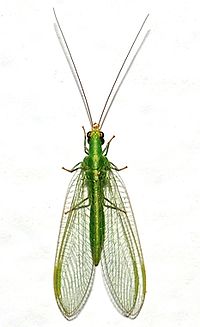- Chrysoperla
-
Chrysoperla Adult Chrysoperla mediterranea Scientific classification Kingdom: Animalia Phylum: Arthropoda Subphylum: Hexapoda Class: Insecta Subclass: Pterygota Infraclass: Neoptera Superorder: Endopterygota Order: Neuroptera Suborder: Hemerobiiformia Superfamily: Chrysopoidea Family: Chrysopidae Subfamily: Chrysopinae Genus: Chrysoperla
Steinmann, 1964Diversity Over 60 species Chrysoperla is a genus of green lacewings in the insect family Chrysopidae in the order Neuroptera. Therein they belong to the Chrysopini, the largest tribe of subfamily Chrysopinae.
Members of this genus and the genus Chrysopa are very common in North America and Europe. They share similar characteristics and some species have been moved from one genus to the other and back. Their larvae are predatory and feed on aphids and members of this genus have been used in biological pest control.[1]
Chrysoperla species are sometimes nearly identical morphologically but can be readily separated based on the vibration signals used to attract mates. For example the southern European Chrysoperla mediterranea looks almost identical to its northern relative C. carnea (Common Green Lacewing), but their courtship "songs" are very different; individuals of one species will not react to the other's vibrations.[2]
Selected species
New species of Chrysoperla are still being described, particularly since the genus contains at least one cryptic species complex.
- Chrysoperla adamsi (Henry, Wells & Pupedis, 1993)
- Chrysoperla affinis
- Chrysoperla agilis Henry, Brooks, Duelli & Johnson, 2003
- Chrysoperla annae
- Chrysoperla argentina
- Chrysoperla asoralis
- Chrysoperla bellatula
- Chrysoperla brevicollis
- Chrysoperla carnea – Common Green Lacewing
- Chrysoperla chusanina
- Chrysoperla comanche (Banks, 1938)
- Chrysoperla comans
- Chrysoperla congrua
- Chrysoperla decaryana
- Chrysoperla defreitasi
- Chrysoperla deserticola
- Chrysoperla downesi (Smith, 1932)
- Chrysoperla dozieri
- Chrysoperla euneura
- Chrysoperla exotera
- Chrysoperla externa (Hagen, 1861)
- Chrysoperla exul
- Chrysoperla furcifera
- Chrysoperla galapagoensis
- Chrysoperla gallagheri
- Chrysoperla genanigra
- Chrysoperla hainanica
- Chrysoperla harrisii (Fitch, 1855)
- Chrysoperla insulata
- Chrysoperla johnsoni (Henry, Wells & Pupedis, 1993)
- Chrysoperla kolthoffi (Navas, 1927)
- Chrysoperla longicaudata
- Chrysoperla lucasina (Lacroix, 1912)
- Chrysoperla lundbladi (Tjeder, 1939)
- Chrysoperla maderensis (Tjeder, 1939)
- Chrysoperla mediterranea (Hölzel, 1972)
- Chrysoperla mexicana
- Chrysoperla mutata (McLachlan, 1898)
- Chrysoperla nigrinervis Brooks, 1994
- Chrysoperla nipponensis
- Chrysoperla nyerina
- Chrysoperla oblita
- Chrysoperla orestes
- Chrysoperla pallida Henry, Brooks, Duelli & Johnson, 2002
- Chrysoperla plicata
- Chrysoperla plorabunda (Fitch, 1855)
- Chrysoperla pudica
- Chrysoperla qinlingensis
- Chrysoperla raimundoi
- Chrysoperla renoni
- Chrysoperla renoni (Lacroix, 1933) (= C. ankylopteryformis)
- Chrysoperla rotundata
- Chrysoperla rufilabris (Burmeister, 1839)
- Chrysoperla siamensis
- Chrysoperla sillemi
- Chrysoperla sola
- Chrysoperla suzukii
- Chrysoperla thelephora
- Chrysoperla volcanicola
- Chrysoperla vulgaris (Schneider, 1851)
- Chrysoperla xizangana
- Chrysoperla yulinica
- Chrysoperla zastrowi
Footnotes
References
- Engel, Michael S. & Grimaldi, David A. (2007): The neuropterid fauna of Dominican and Mexican amber (Neuropterida, Megaloptera, Neuroptera). Am. Mus. Novit. 3587: 1–58. PDF fulltext
- Henry, Charles S.; Brooks, Stephen J.; Johnson, James B. & Duelli, Peter (1999): Revised concept of Chrysoperla mediterranea (Hölzel), a green lacewing associated with conifers: courtship songs across 2800 kilometres of Europe (Neuroptera: Chrysopidae). Systematic Entomology 24(4): 335–350. doi:10.1046/j.1365-3113.1999.00085.x PDF fulltext
- New, T.R. (2002): Prospects for extending the use of Australian lacewings in biological control. Acta Zool. Acad. Sci. Hung. 48(Supplement 2): 209–216. PDF fulltext
This Neuroptera related article is a stub. You can help Wikipedia by expanding it.

